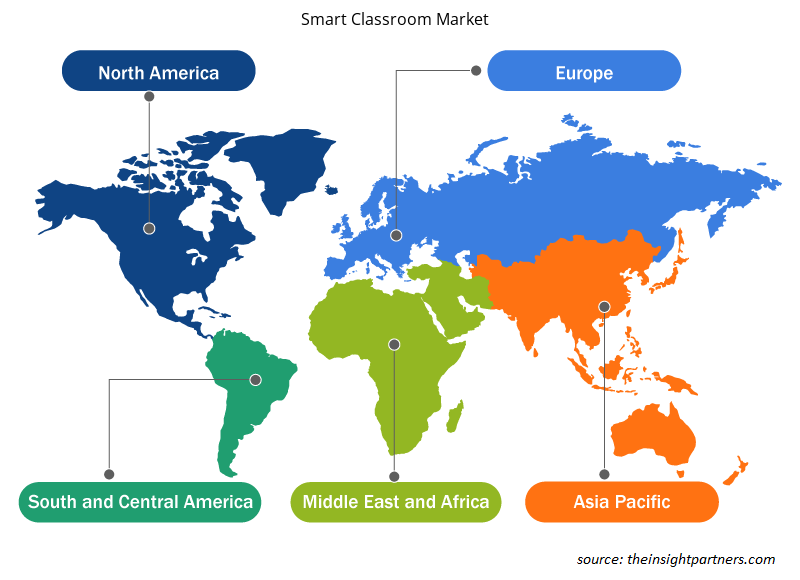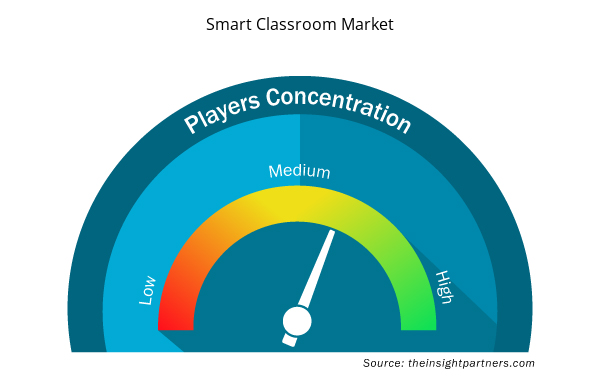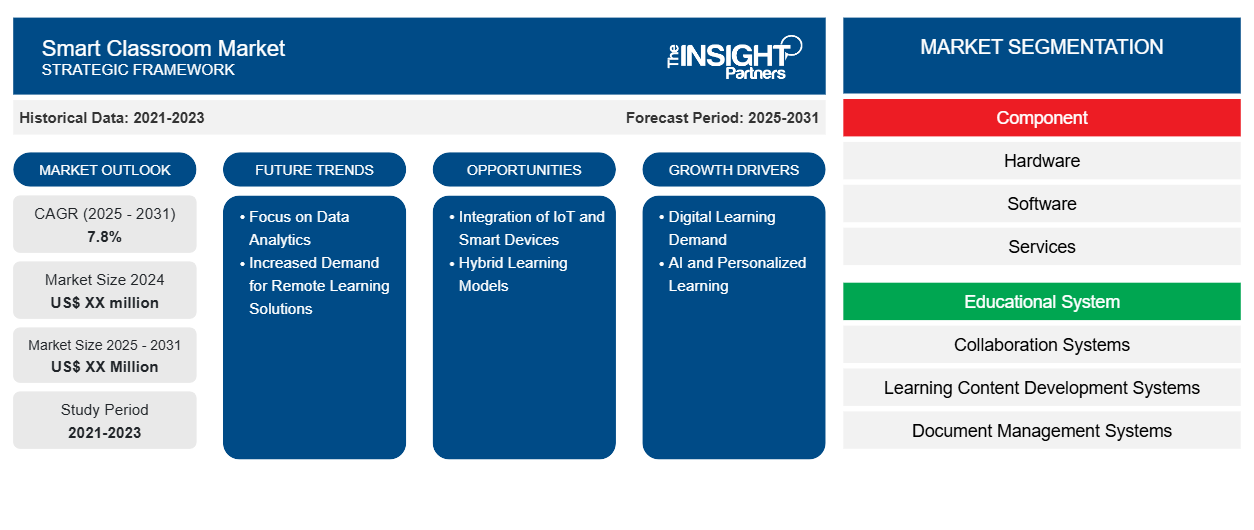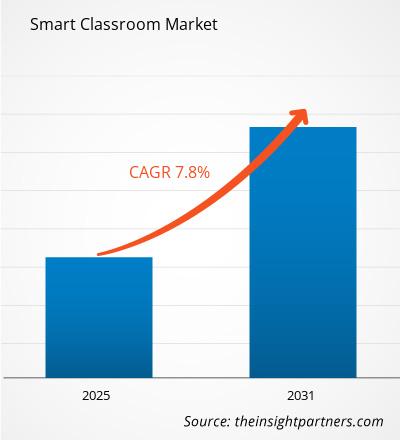Es wird erwartet, dass der Markt für intelligente Klassenräume von 2024 bis 2031 eine durchschnittliche jährliche Wachstumsrate (CAGR) von 7,8 % verzeichnet, wobei die Marktgröße von XX Millionen US-Dollar im Jahr 2024 auf XX Millionen US-Dollar im Jahr 2031 anwachsen wird.
Der Bericht ist segmentiert nach Komponenten (Hardware, Software, Dienste), Bildungssystemen (Kollaborationssysteme, Lerninhaltsentwicklungssysteme, Dokumentenmanagementsysteme, Schülerantwortsysteme, Lernmanagementsysteme, Inhaltserstellungssysteme, Klassenraummanagementsysteme, Sonstige), Anwendungen (Lernspiele, Bildungssicherheit, Bildungs-ERP), Endverbrauch (Kindergarten, K-12, Hochschulbildung). Die globale Analyse ist weiter auf regionaler Ebene und in die wichtigsten Länder unterteilt. Der Bericht bietet den Wert in USD für die oben genannte Analyse und die Segmente.
Zweck des Berichts
Der Bericht Smart Classroom Market von The Insight Partners zielt darauf ab, die aktuelle Landschaft und das zukünftige Wachstum sowie die wichtigsten treibenden Faktoren, Herausforderungen und Chancen zu beschreiben. Dies wird verschiedenen Geschäftspartnern Einblicke geben, wie zum Beispiel:
- Technologieanbieter/-hersteller: Um die sich entwickelnde Marktdynamik zu verstehen und die potenziellen Wachstumschancen zu kennen, damit sie fundierte strategische Entscheidungen treffen können.
- Investoren: Durchführung einer umfassenden Trendanalyse hinsichtlich der Marktwachstumsrate, der finanziellen Marktprognosen und der Chancen entlang der Wertschöpfungskette.
- Regulierungsbehörden: Zur Regulierung von Richtlinien und Überwachungsaktivitäten auf dem Markt mit dem Ziel, Missbrauch zu minimieren, das Vertrauen der Anleger zu bewahren und die Integrität und Stabilität des Marktes aufrechtzuerhalten.
Marktsegmentierung für intelligente Klassenzimmer
Komponente
- Hardware
- Software
- Dienstleistungen
Bildungssystem
- Kollaborationssysteme
- Systeme zur Entwicklung von Lerninhalten
- Dokumentenmanagementsysteme
- Student-Response-Systeme
- Lernmanagementsysteme
- Systeme zur Inhaltserstellung
- Klassenraum-Management-Systeme
- Sonstiges
Anwendung
- Pädagogische Spiele
- Bildungssicherheit
- ERP für Bildungseinrichtungen
Endverwendung
- Kindergarten
- K-12
- Höhere Bildung
Passen Sie diesen Bericht Ihren Anforderungen an
Sie erhalten kostenlos individuelle Anpassungen an jedem Bericht, einschließlich Teilen dieses Berichts oder einer Analyse auf Länderebene, eines Excel-Datenpakets sowie tolle Angebote und Rabatte für Start-ups und Universitäten.
- Holen Sie sich die wichtigsten Markttrends aus diesem Bericht.Dieses KOSTENLOSE Beispiel umfasst eine Datenanalyse von Markttrends bis hin zu Schätzungen und Prognosen.
Wachstumstreiber auf dem Markt für intelligente Klassenzimmer
- Nachfrage nach digitalem Lernen: Ein wichtiger Trend, der zur Entstehung des Marktes für intelligente Klassenzimmer führt, ist auf die Art und Weise zurückzuführen, wie digitale Lösungen beim Lernen eingesetzt werden. Da Schüler, Schulen und Universitäten nach einer völlig anderen, flexiblen und zugänglichen Art des Lernens suchen, zeigen Bildungseinrichtungen die Bereitschaft, intelligente Technologien einzusetzen, um das Lernen spannend zu gestalten. Es geht nicht mehr nur darum, alte Methoden durch neue Plattformen zu ersetzen, sondern tatsächlich um eine völlige Neuausrichtung dessen, was Lernen und Lehren bedeuten. Online-Kurse und Blended Learning-Ansätze werden zur Norm, wobei Schulen und Universitäten zunehmend in Spitzentechnologien investieren müssen, die dieses Lernen interaktiv und spannend machen.
- KI und personalisiertes Lernen: KI-basierte Tools haben die Bildungspraxis verändert, indem sie individualisierte Lernpfade eingeführt haben, die auf die Bedürfnisse verschiedener Schüler eingehen. Mithilfe von Datenanalysen können solche Technologien beispielsweise die Leistung und Präferenzen der Schüler untersuchen, um einen effektiven, maßgeschneiderten Unterricht und eine effektive Ressourcenzuweisung zu ermöglichen. Mit diesen Maßnahmen wird das Lernen spannender und relevanter, was die Motivation und die akademischen Ergebnisse der betreffenden Schüler erhöht. Diese Art der mobilen Anpassung von Lernressourcen und -methoden vermittelt nicht nur ein tieferes Verständnis der Materie, sondern ermöglicht es den Schülern auch, ihren Lernprozess zu meistern. In diesem Zusammenhang gewinnen KI-basierte Lösungen in modernen Bildungseinrichtungen immer mehr an Popularität, da sie den sich dynamisch ändernden Erwartungen von Lehrern und Lernenden in einer digital geprägten Welt besser gerecht werden.
Zukünftige Trends auf dem Smart Classroom-Markt
- Fokus auf Datenanalyse: Datenanalyse ist ein Bereich, in dem im Bildungsbereich ein erhebliches Wachstum erwartet wird, da sie die Lehr- und Lernweise von Pädagogen zu verändern beginnt. Pädagogen können mithilfe von Datenanalysen tief in die Leistung, das Engagement und die Lernmuster der Schüler eintauchen und so ein besseres Verständnis davon gewinnen, wie einzelne Schüler lernen und mit Lernschwierigkeiten umgehen. Mit der Möglichkeit, so unterschiedliche Kennzahlen wie Anwesenheit und Teilnahme sowie Abschlussquoten bei Aufgaben zu analysieren, können Pädagogen wirklich damit beginnen, Trends zu erkennen und einzugreifen, bevor die Schüler wirklich in Schwierigkeiten geraten. Dadurch funktionieren Lehrstrategien besser und gleichzeitig wird eine persönlichere Lernerfahrung für diese Schüler ermöglicht, was wiederum zu besseren Schülerergebnissen und einer intensiveren Auseinandersetzung mit dem Lernstoff führt.
- Erhöhte Nachfrage nach Lösungen für Fernunterricht: Der Aufstieg von Fern- und Hybrid-Lernmodellen hat die Nachfrage nach intelligenten Unterrichtstechnologien, die Online-Bildung ermöglichen, gesteigert. Tools, die virtuelle Zusammenarbeit, interaktiven Unterricht und Echtzeit-Feedback unterstützen, werden für Pädagogen und Schüler gleichermaßen unverzichtbar. Dieser Trend unterstreicht den Bedarf an flexiblen Lernumgebungen, die sich an veränderte Bildungslandschaften anpassen können.
Marktchancen für Smart Classroom
- Integration von IoT und Smart Devices: Eine solche Integration ermöglicht die vollständige Umsetzung von Interaktivität und Konnektivität im Klassenzimmer und macht es zu einem interessanten Lernort für die Schüler. Der Einsatz von Sensoren und Konnektivität in alltäglichen Unterrichtswerkzeugen hat Pädagogen die Möglichkeit gegeben, Echtzeitkommunikation und Datenaustausch zwischen Geräten zu entwickeln, ein Setup, das Teamarbeit und aktive Teilnahme der Schüler fördert. Dies bereichert nicht nur das Bildungserlebnis, sondern fördert auch die Einführung intelligenter Klassenzimmertechnologien, da sich die Institutionen der Bedeutung vernetzter Lernökosysteme stärker bewusst werden.IoT and Smart Devices: Such integration allows the full implementation of interactivity and connectivity in the classroom and makes it an interesting learning place for the students. The use of sensors and connectivity in everyday classroom tools has given educators opportunities to develop real-time communication and data exchange between devices, a set-up that encourages teamwork and active participation for students. This not only enriches the educational experience but also positively promotes the uptake of smart classroom technologies since institutions become more aware of the importance of connected learning ecosystems.
- Hybride Lernmodelle: Hybride Lernmodelle revolutionieren derzeit die Schullandschaft durch gemischte Präsenz- und Online-Unterrichtsformen. Sie werden zu einer Plattform, die ein vielseitiges Lernerlebnis bietet, das den unterschiedlichen Bedürfnissen und Anforderungen der Schüler gerecht wird. So können unterschiedliche Lernstile und -präferenzen berücksichtigt werden. Da sich das Bildungsumfeld weiterentwickelt, wird der Bedarf an hybriden Modellen voraussichtlich bestehen bleiben, um den sich ändernden Bedürfnissen der Schüler und des gesamten Bildungsumfelds gerecht zu werden. Dazu gehört die Integration von IoT in hybride Lernmodelle für ein reaktionsfähigeres Bildungssystem.IoT within hybrid learning models for a more responsive education system.
Regionale Einblicke in den Smart Classroom-Markt
Die regionalen Trends und Faktoren, die den Smart Classroom-Markt während des Prognosezeitraums beeinflussen, wurden von den Analysten von Insight Partners ausführlich erläutert. In diesem Abschnitt werden auch die Marktsegmente und die Geografie des Smart Classroom-Marktes in Nordamerika, Europa, im asiatisch-pazifischen Raum, im Nahen Osten und Afrika sowie in Süd- und Mittelamerika erörtert.

- Holen Sie sich regionale Daten zum Smart Classroom-Markt
Umfang des Marktberichts zum intelligenten Klassenzimmer
| Berichtsattribut | Details |
|---|---|
| Marktgröße im Jahr 2024 | XX Millionen US-Dollar |
| Marktgröße bis 2031 | XX Millionen US-Dollar |
| Globale CAGR (2025 - 2031) | 7,8 % |
| Historische Daten | 2021-2023 |
| Prognosezeitraum | 2025–2031 |
| Abgedeckte Segmente | Nach Komponente
|
| Abgedeckte Regionen und Länder | Nordamerika
|
| Marktführer und wichtige Unternehmensprofile |
|
Dichte der Marktteilnehmer für Smart Classroom-Anwendungen: Die Auswirkungen auf die Geschäftsdynamik verstehen
Der Markt für intelligente Klassenzimmer wächst rasant. Dies wird durch die steigende Nachfrage der Endnutzer aufgrund von Faktoren wie sich entwickelnden Verbraucherpräferenzen, technologischen Fortschritten und einem größeren Bewusstsein für die Vorteile des Produkts vorangetrieben. Mit der steigenden Nachfrage erweitern Unternehmen ihr Angebot, entwickeln Innovationen, um die Bedürfnisse der Verbraucher zu erfüllen, und nutzen neue Trends, was das Marktwachstum weiter ankurbelt.
Die Marktteilnehmerdichte bezieht sich auf die Verteilung der Firmen oder Unternehmen, die in einem bestimmten Markt oder einer bestimmten Branche tätig sind. Sie gibt an, wie viele Wettbewerber (Marktteilnehmer) in einem bestimmten Marktraum im Verhältnis zu seiner Größe oder seinem gesamten Marktwert präsent sind.
Die wichtigsten Unternehmen auf dem Smart Classroom-Markt sind:
- FUJITSU
- Educomp Solutions GmbH
- HCL Learning Limited
- HP Development Company, LP
- Jenzabar, Inc.
Haftungsausschluss : Die oben aufgeführten Unternehmen sind nicht in einer bestimmten Reihenfolge aufgeführt.

- Überblick über die wichtigsten Akteure auf dem Smart Classroom-Markt
Wichtige Verkaufsargumente
- Umfassende Abdeckung: Der Bericht deckt die Analyse von Produkten, Diensten, Typen und Endbenutzern des Smart Classroom-Marktes umfassend ab und bietet einen ganzheitlichen Überblick.
- Expertenanalyse: Der Bericht basiert auf dem umfassenden Verständnis von Branchenexperten und Analysten.
- Aktuelle Informationen: Der Bericht stellt durch die Abdeckung aktueller Informationen und Datentrends Geschäftsrelevanz sicher.
- Anpassungsoptionen: Dieser Bericht kann angepasst werden, um spezifische Kundenanforderungen zu erfüllen und die Geschäftsstrategien optimal anzupassen.
Der Forschungsbericht zum Smart Classroom-Markt kann daher dabei helfen, die Branchensituation und Wachstumsaussichten zu entschlüsseln und zu verstehen. Obwohl es einige berechtigte Bedenken geben kann, überwiegen die allgemeinen Vorteile dieses Berichts tendenziell die Nachteile.
- Historische Analyse (2 Jahre), Basisjahr, Prognose (7 Jahre) mit CAGR
- PEST- und SWOT-Analyse
- Marktgröße Wert/Volumen – Global, Regional, Land
- Branche und Wettbewerbsumfeld
- Excel-Datensatz


- Surgical Gowns Market
- Educational Furniture Market
- Neurovascular Devices Market
- Excimer & Femtosecond Ophthalmic Lasers Market
- Single Pair Ethernet Market
- Hydrogen Compressors Market
- Intraoperative Neuromonitoring Market
- Small Molecule Drug Discovery Market
- Advanced Planning and Scheduling Software Market
- Hand Sanitizer Market

Report Coverage
Revenue forecast, Company Analysis, Industry landscape, Growth factors, and Trends

Segment Covered
This text is related
to segments covered.

Regional Scope
North America, Europe, Asia Pacific, Middle East & Africa, South & Central America

Country Scope
This text is related
to country scope.
Häufig gestellte Fragen
Some of the customization options available based on the request are an additional 3-5 company profiles and country-specific analysis of 3-5 countries of your choice. Customizations are to be requested/discussed before making final order confirmation as our team would review the same and check the feasibility
The report can be delivered in PDF/PPT format; we can also share excel dataset based on the request
Focus on Data Analytics is anticipated to play a significant role in the global smart classroom market in the coming years
The major factors driving the smart classroom market are:
1. Digital Learning Demand
2. AI and Personalized Learning
The Smart Classroom Market is estimated to witness a CAGR of 7.8% from 2023 to 2031
-
Trends and growth analysis reports related to Electronics and Semiconductor : READ MORE..
1. FUJITSU
2. Educomp Solutions Ltd
3. HCL Learning Limited
4. HP Development Company, L.P.
5. Jenzabar, Inc.
6. Lenovo
7. Microsoft
8. Pearson India Education Services Pvt. Ltd
9. SAMSUNG
10. Smart Technologies
The Insight Partners performs research in 4 major stages: Data Collection & Secondary Research, Primary Research, Data Analysis and Data Triangulation & Final Review.
- Data Collection and Secondary Research:
As a market research and consulting firm operating from a decade, we have published and advised several client across the globe. First step for any study will start with an assessment of currently available data and insights from existing reports. Further, historical and current market information is collected from Investor Presentations, Annual Reports, SEC Filings, etc., and other information related to company’s performance and market positioning are gathered from Paid Databases (Factiva, Hoovers, and Reuters) and various other publications available in public domain.
Several associations trade associates, technical forums, institutes, societies and organization are accessed to gain technical as well as market related insights through their publications such as research papers, blogs and press releases related to the studies are referred to get cues about the market. Further, white papers, journals, magazines, and other news articles published in last 3 years are scrutinized and analyzed to understand the current market trends.
- Primary Research:
The primarily interview analysis comprise of data obtained from industry participants interview and answers to survey questions gathered by in-house primary team.
For primary research, interviews are conducted with industry experts/CEOs/Marketing Managers/VPs/Subject Matter Experts from both demand and supply side to get a 360-degree view of the market. The primary team conducts several interviews based on the complexity of the markets to understand the various market trends and dynamics which makes research more credible and precise.
A typical research interview fulfils the following functions:
- Provides first-hand information on the market size, market trends, growth trends, competitive landscape, and outlook
- Validates and strengthens in-house secondary research findings
- Develops the analysis team’s expertise and market understanding
Primary research involves email interactions and telephone interviews for each market, category, segment, and sub-segment across geographies. The participants who typically take part in such a process include, but are not limited to:
- Industry participants: VPs, business development managers, market intelligence managers and national sales managers
- Outside experts: Valuation experts, research analysts and key opinion leaders specializing in the electronics and semiconductor industry.
Below is the breakup of our primary respondents by company, designation, and region:

Once we receive the confirmation from primary research sources or primary respondents, we finalize the base year market estimation and forecast the data as per the macroeconomic and microeconomic factors assessed during data collection.
- Data Analysis:
Once data is validated through both secondary as well as primary respondents, we finalize the market estimations by hypothesis formulation and factor analysis at regional and country level.
- Macro-Economic Factor Analysis:
We analyse macroeconomic indicators such the gross domestic product (GDP), increase in the demand for goods and services across industries, technological advancement, regional economic growth, governmental policies, the influence of COVID-19, PEST analysis, and other aspects. This analysis aids in setting benchmarks for various nations/regions and approximating market splits. Additionally, the general trend of the aforementioned components aid in determining the market's development possibilities.
- Country Level Data:
Various factors that are especially aligned to the country are taken into account to determine the market size for a certain area and country, including the presence of vendors, such as headquarters and offices, the country's GDP, demand patterns, and industry growth. To comprehend the market dynamics for the nation, a number of growth variables, inhibitors, application areas, and current market trends are researched. The aforementioned elements aid in determining the country's overall market's growth potential.
- Company Profile:
The “Table of Contents” is formulated by listing and analyzing more than 25 - 30 companies operating in the market ecosystem across geographies. However, we profile only 10 companies as a standard practice in our syndicate reports. These 10 companies comprise leading, emerging, and regional players. Nonetheless, our analysis is not restricted to the 10 listed companies, we also analyze other companies present in the market to develop a holistic view and understand the prevailing trends. The “Company Profiles” section in the report covers key facts, business description, products & services, financial information, SWOT analysis, and key developments. The financial information presented is extracted from the annual reports and official documents of the publicly listed companies. Upon collecting the information for the sections of respective companies, we verify them via various primary sources and then compile the data in respective company profiles. The company level information helps us in deriving the base number as well as in forecasting the market size.
- Developing Base Number:
Aggregation of sales statistics (2020-2022) and macro-economic factor, and other secondary and primary research insights are utilized to arrive at base number and related market shares for 2022. The data gaps are identified in this step and relevant market data is analyzed, collected from paid primary interviews or databases. On finalizing the base year market size, forecasts are developed on the basis of macro-economic, industry and market growth factors and company level analysis.
- Data Triangulation and Final Review:
The market findings and base year market size calculations are validated from supply as well as demand side. Demand side validations are based on macro-economic factor analysis and benchmarks for respective regions and countries. In case of supply side validations, revenues of major companies are estimated (in case not available) based on industry benchmark, approximate number of employees, product portfolio, and primary interviews revenues are gathered. Further revenue from target product/service segment is assessed to avoid overshooting of market statistics. In case of heavy deviations between supply and demand side values, all thes steps are repeated to achieve synchronization.
We follow an iterative model, wherein we share our research findings with Subject Matter Experts (SME’s) and Key Opinion Leaders (KOLs) until consensus view of the market is not formulated – this model negates any drastic deviation in the opinions of experts. Only validated and universally acceptable research findings are quoted in our reports.
We have important check points that we use to validate our research findings – which we call – data triangulation, where we validate the information, we generate from secondary sources with primary interviews and then we re-validate with our internal data bases and Subject matter experts. This comprehensive model enables us to deliver high quality, reliable data in shortest possible time.


 Holen Sie sich ein kostenloses Muster für diesen Bericht
Holen Sie sich ein kostenloses Muster für diesen Bericht